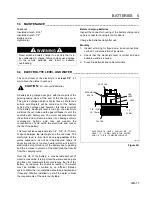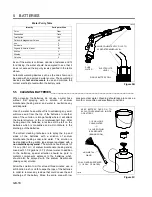
5 BATTERIES
GB-22
5.10 PROLONGED STORAGE ____________________________________________________
During periods of storage, the batteries will need
attention to keep them maintained and prevent
discharge.
In high temperatures the chemical reaction is faster, while
low temperatures cause the chemical reaction to slow
down. A vehicle that is stored at 90
°
F (32
°
C) will
lose.002 of specific gravity each day. If a fully charged
battery has a specific gravity of 1.275, and the battery is
allowed to sit unused, it will become partially discharged.
When it reaches 1.240 which it will do in less than twenty
days, it should be recharged.
If a battery is left in a discharged state, sulfation takes
place on and within the plates. This condition is not
reversible and will cause permanent damage to the
battery. In order to prevent damage, the battery should be
recharged. A hydrometer can be used to determine the
specific gravity and therefore the state of charge of a
battery.
In winter conditions, the battery must be fully charged to
prevent the possibility of freezing. A fully charged battery
will not freeze in the most severe of winter climates.
Although the chemical reaction is slowed in cold
temperatures, the battery must be stored fully charged,
and disconnected from any circuit that could discharge
the battery. Disconnect the charging plug from the vehicle
receptacle. The batteries must be cleaned and all
deposits neutralized and removed from the battery case
to prevent self discharge. The batteries should be tested
or recharged at thirty day intervals.
Figure 5F
5.11 CHARGER INSTALLATION __________________________________________________
Install all chargers in accordance with the manufacturers
instructions.
If the charger is operated in an outdoor location, rain
and sun protection must be provided.
In portable applications, the charging (DC) cord is
equipped with a polarized connector which fits into a
matching receptacle on the vehicle.
The power (AC) cord is equipped with an appropriate
plug. If the charger is equipped with a grounding plug,
do not attempt to defeat its functionality.
Note: If your vehicle is to be charged with a non-
standard charger, refer to the instructions supplied with
the charger.
TR011
WARNING
Portable chargers should be mounted on a platform
above the ground, or in such a manner as to permit
the maximum air flow underneath and around the
charger. If the charger is mounted such that sufficient
air flow is prevented from entering the louvers,
overheating may result which could cause serious
damage to the charger and potential for fire
!
!
WARNING
An ungrounded electrical device may become a
physical hazard that could result in an electrical shock
or electrocution
!
!
















































